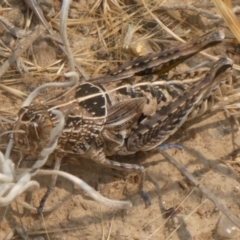Perunga ochracea (Perunga grasshopper, Cross-dressing Grasshopper)
The species appears to have a small range stretching 180 km east–west and 150 km north–south and including Murrumbateman, Gundaroo, the ACT and Bungendore. However, the area of occupancy within much of this range is likely to be low because habitat alteration and fragmentation have reduced or destroyed populations.
This small grasshopper is characterised by a pale cross on the upper side of the thorax and vestigial wings. The species is flightless—but it can leap more than a metre. Females are about 30 millimetres long and males about half that. The colours on its back can vary from year to year, with a tendency toward grey-brown in dry years and greenish in wet years.
Nymphs hatch in late summer and autumn and develop over the winter and early spring. They only have a 12-month cycle. The grasshoppers eat forbs (small flowering plants).
Roger Farrow proposes that the common name for this species, which mainly occurs in the Canberra area, be the Cross-dressing Grasshopper so people remember the name and look out for it. The name is appropriate as it has a cross on its back, can change its colour from flourescent green to khaki brown depending on the colour of the grass around it, the extremities of its feet are blue and look like it is wearing blue high heels, and its wings are just stumps, only useful as fashion accessories
Please try not to handle this grasshopper as it can easily cause a leg(s) to be lost.
Further references:
Perunga ochracea is listed in the following regions:
Canberra & Southern Tablelands
Species information
- Perunga ochracea Scientific name
- Perunga grasshopper, Cross-dressing Grasshopper Common name
- Not Sensitive
- Endangered *
- Non-invasive or negligible
- Up to 816.55m Recorded at altitude
- Machine learning
- External link More information
Location information
-
Maps
Budjan Galindji (Franklin Grassland) Reserve Bullen Range Crace Grasslands Dunlop Grasslands Gang Gang at Yass River Ginninderry Conservation Corridor Goorooyarroo NR (ACT) Gundaroo Common Gungaderra Grasslands Hill Reserve Hoover Reserve Isaacs Ridge Isaacs Ridge and Nearby Jerrabomberra Grassland Kama Lake Ginninderra Lawson North Grasslands Lower Molonglo Mawson Ponds Molonglo River Reserve Mount Painter Mulanggari Grasslands Mulligans Flat Nadjung Mada NR O'Connor Ridge to Gungahlin Grasslands Pine Island to Point Hut Red Hill Nature Reserve Scrivener Hill Tuggeranong Hill Wandiyali-Environa Conservation Area Yarramundi Grassland -
Places
Denman Prospect, ACT Hall, ACT Mawson, ACT Mitchell, ACT Molonglo, ACT Ngunnawal, ACT Theodore, ACT Whitlam, ACT

















































































































































































